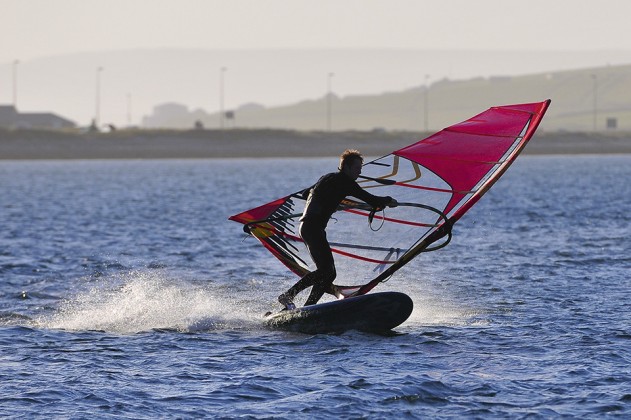THE THIN (WIDE) LINE – 130L FREERIDE BOARD TEST 2015
Test Editor Tris Best // Second Testers Maurin Rottenwalter, Joe North
Photos Andy Stallman // Test Location OTC, PORTLAND
Until now, the large freeride board was unquestionably the domain of the progressing intermediate rider … but with the introduction of the wide-thin concept and explosion of options provided by brands for 2015, is there a little more to the large freeride hull now? We asked our test team to investigate.
This test was originally published in the July 2015 issue.
Call it what you will, the ‘wide-thin’ board design has been present in the freeride market for a few years now and has really captured the imagination of most in the small to medium board sizes (100-120L). A few brands pushed on and developed full ranges of this new generation of boards, whilst others have only just caught up for this season. So would the principles of the concept be transferrable and as relevant to the larger boards in the series?
FINDINGS
Putting these boards on the mats in front of the centre for a quick inspection before heading out on the water, you can’t help but notice one thing immediately. They really are wide! With an average maximum width of 84cm (excluding the Fanatic) they are comparable or bigger than the widest boards most slalom competitors (be it national or international) would have in their quiver. And a quick glance at the recommended sail sizes for each board will confirm the story. So have the brands gone too wide? The beauty with conducting the test at the centre is that we can get a variety of abilities on the boards to really test their potential with a true cross section of the market and the exact target market for the hulls. So it wasn’t long before a reservation about the new designs started to get fed back to us – that some intermediate riders were really struggling to get these wide thin boards to release onto the plane. Such is the width in the mid-section and shoulders of the boards that they really need to be stuffed deep off the wind to rise up with any purpose. And the big issue is that this is a principle that instantly conflicts with the intermediate rider’s inner battle to maintain ground upwind. The other more predictable problem was moving out into the straps, with their position being right out on the rail – a leap too far for some who tried.
However, with some gentle tuition and technique adjustments to get their heads around this new style of riding, they quickly realised the benefits and rewards of this wide-thin generation. Super stable with immense weight carrying capacity in marginal winds, they DO release early and whilst perhaps not a match for your typical freerace hull, do provide a good turn of speed and excitement. But their real trump card is their ease and practicality over an extraordinary wind range, combined with fantastic glide and versatility in the turns. When the going gets tough, the boards tend to stay planted to the water and if they show any hint of misbehaving, are easy to bring back under control by the rider changing their stance and approach.
In the small freeride board market the advantages of the wide-thin design were overwhelming and clear to see. They had been adopted unreservedly by every brand and their boards were all the better for it. But, true to the nature of the beast, the brands were designing the boards with a more experienced rider clientele base in mind. Could there be a limit to the scope and significance of the concept? Is the wide-thin board a step too far for the discerning intermediate? There is certainly one brand here that thinks so. At 246cm in length and 78cm wide, the Fanatic Gecko 133 is noticeably longer and narrower than the others here, fitting the dimensions of a more conventionally shaped freeride hull. How would it stack up against its roller-pinned rivals?
SUMMARY
Taking a lead from past trends and directions in the sport, you would expect an experienced rider to benefit most by wandering down the freerace/slalom board path (see the test in last month’s issue), whereas these large freeride boards offer more ease and user-friendliness, particularly in challenging conditions. You can certainly stand more upright over them and relax into your stance, rather than being ‘on edge’ all the time. Yet what surprised us is that if you commit to a locked-in stance, the performance offered in return is not to be sniffed at. Yes, it will take time to adjust to the concept and some may find the step too far, but the advantages are there to see. The Fanatic is the most traditional board here – super easy and passive to use, it has a built in autopilot to help the intermediate rider progress smoothly into planing conditions. The JP and RRD require a technique adjustment but reward with ease and performance over a staggering wind range. The Starboard is a lively contender – perhaps not as effortless to tap into its light-wind performance, it has real life and energy once going and is an amazing tutor for cornering and transitions. That brings us onto the Rocket Wide by Tabou. The thinnest and lowest volume here, it requires more rider input to get going and once released it offers the ease and user-friendliness you’d expect, but marries it with a performance to keep up with most freerace hulls. If it shows anything it is that this wide-thin concept has a place in the large freeride sector and we believe is here to stay. The Tabou is one of the latest brands on the market with their wide-thin contender, claiming to have spent considerable R&D time developing a product until they were happy with it. It certainly leads the way in terms of performance, so it will be interesting to see how the concept continues to develop from here. Watch this space…
THE OTC
This test was conducted at the Official Test Centre (OTC) at Portland, Dorset. The OTC centre is based within the grounds of the National Sailing Academy that hosted the Olympic sailing classes in 2012. With the best wind stats on the south coast, mirror flat water in prevailing winds and a safe launch area with excellent facilities, it provides the ideal test venue. Much of the kit is still on site, so why not go and try some of it for yourself?
THE LINE-UP


